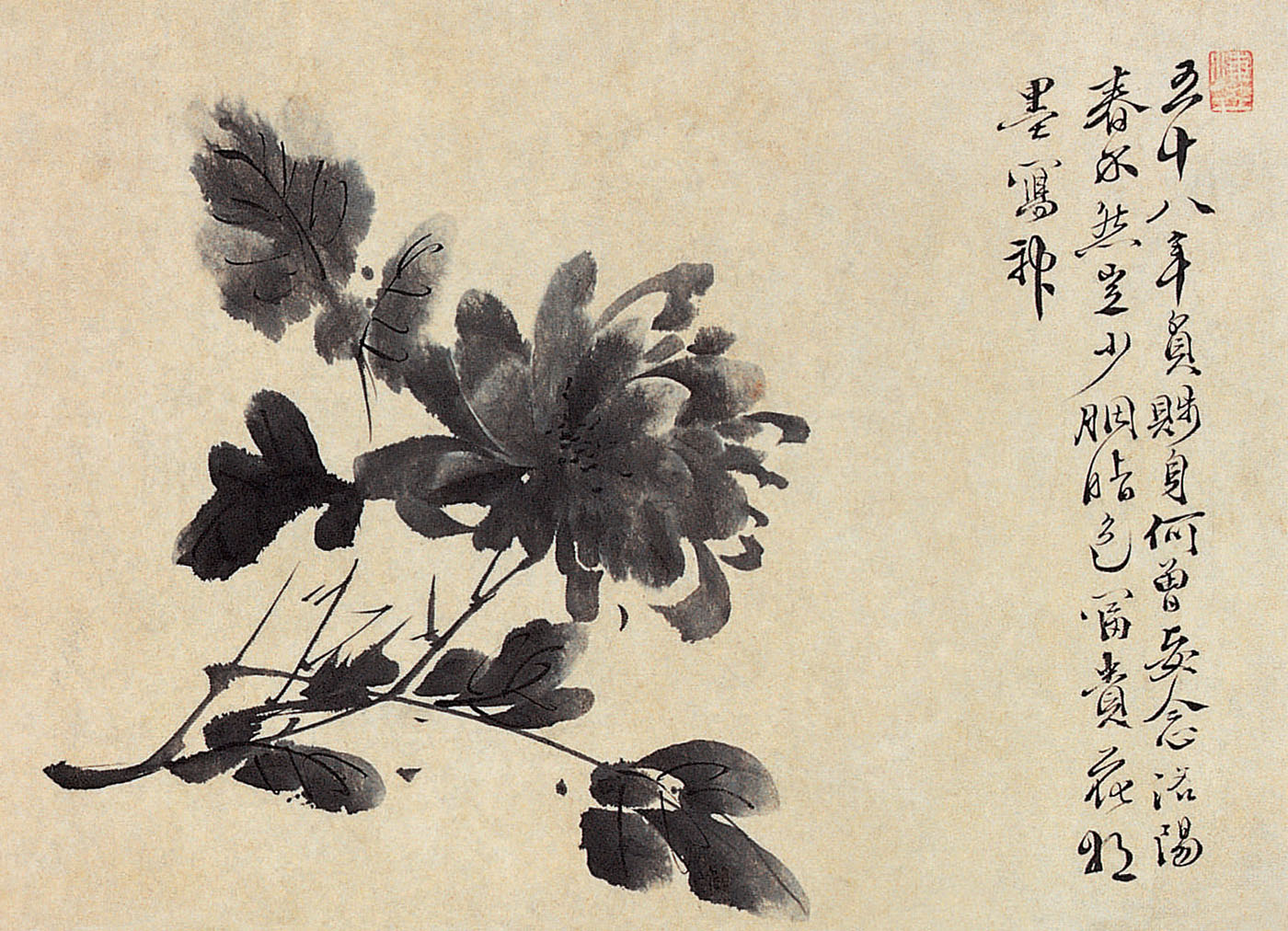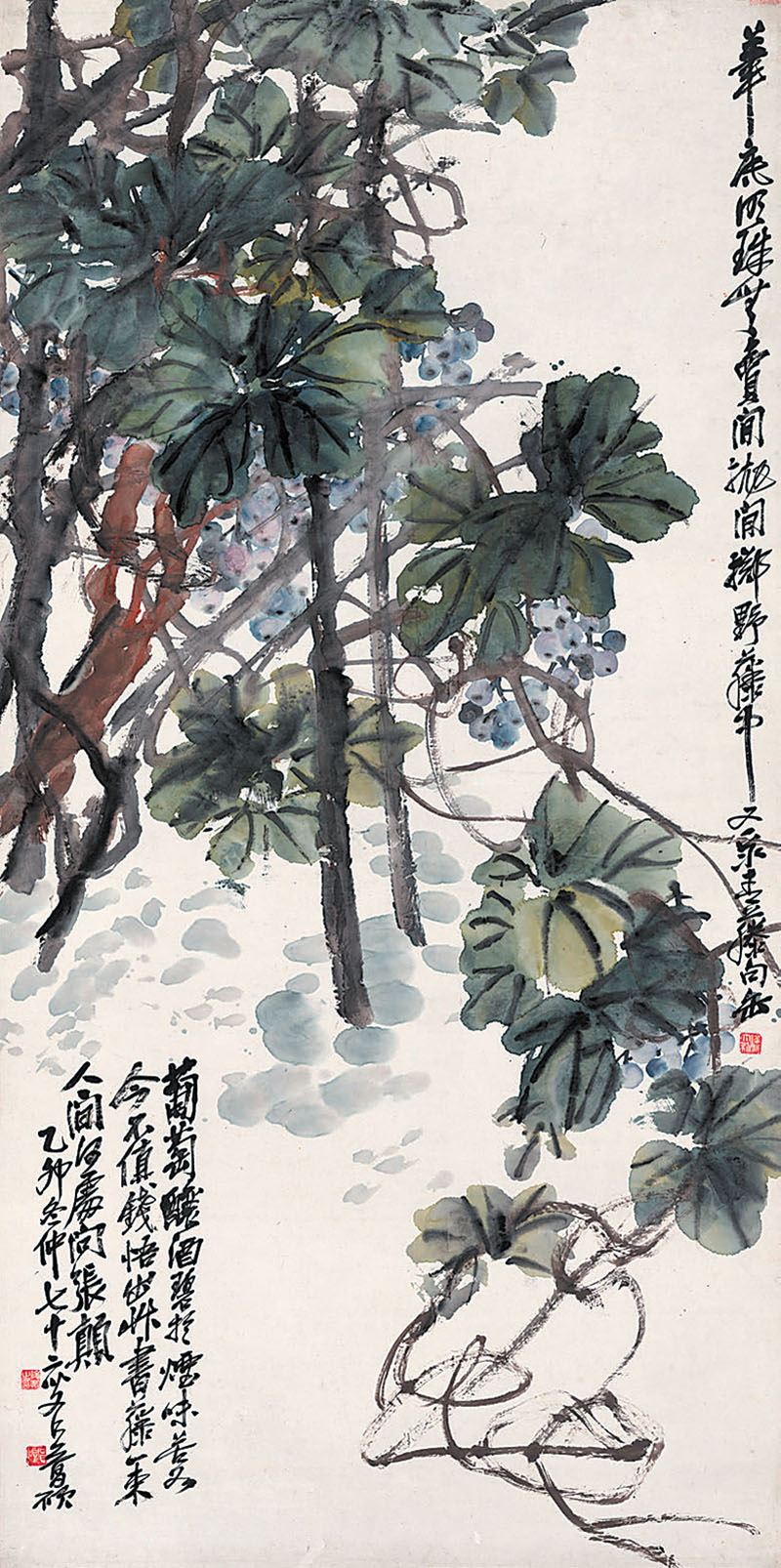Exhibition showcases understated elegance and transcendental qualities with muted shades of color and a minimalist depiction of subjects, Lin Qi reports.

An exhibition of works by a renowned ink artist and his three mentors drew people to the Art Museum of Beijing Fine Art Academy at the end of the Golden Week holiday. Despite living in different eras, all four artists embraced a revolutionary spirit that has left a long-lasting influence on Chinese art history.
The spotlight of the exhibition was Qi Baishi (1864-1957), an eminent figure of modern ink art, and his three renowned "teachers": Xu Wei of the 16th century, Zhu Da (1626-1705) — better known by the pseudonym Bada Shanren — and Wu Changshuo (1844-1927). Works by the four painters were brought together from various museums across the country at the exhibition Brushstrokes Across Centuries, which is on show at the Art Museum of Beijing Fine Art Academy until Dec 5.
READ MORE: Brushstrokes celebrate nature's vigor
Qi was elected the honorary dean of Beijing Fine Art Academy when it was established in May 1957, about four months before he died. The academy holds an abundant collection of Qi's works and documents and administers Qi's former residence, a siheyuan-style courtyard which is now a museum.

The exhibition marks the 20th anniversary of the Art Museum of Beijing Fine Art Academy, an occasion that the academy's head Wu Hongliang wants to mark by mounting a unique and unprecedented show that would have struck a chord in the heart of Qi if he were alive to see it.
The theme stemmed from a poem of Qi's which expressed his admiration for his three artistic heroes in a way no less significant than idol worship in pop culture today.
Wu says that among the many great artists in history whom Qi studied, these three illuminated the xieyi (drawing the spirit) tradition of classic Chinese painting, and nourished Qi the most in his own attempts at xieyi.
To showcase the evolution of art practiced by the four painters and compare their creative works, Wu's colleagues reached out to museums and cultural institutions across the country to borrow their exhibits, including the National Art Museum of China, Nanjing Museum in Jiangsu province and Liaoning Provincial Museum in Shenyang, Liaoning province, as well as Beijing-based Rong Bao Zhai, the time-honored cultural brand from which Qi used to order fine-quality paper.

Technically, the xieyi style prioritizes expansive washes of ink and muted shades of color over precise delineation of the subjects. This minimalist treatment accentuates an understated beauty and otherworldly tendencies.
The exhibition shows how the four featured painters championed the style not only for artistic creativity, but also because it allowed them to embed their personas, individuality and world views in every stroke.
Wu says the exhibition is "a key", "an invisible hand", to open the studios of the four men to visitors.
The first stop of this journey through centuries takes people into the mind of Xu Wei. Hailed as a child prodigy for his skill in painting and poetry, Xu, however, led a turbulent life, falling victim to the political darkness of the mid-to-late stages of the Ming Dynasty (1368-1644).Although viewed as unhinged by some, Xu created, with unbounded strokes, a vigorous world, especially through his depiction of plants and flowers.
"He splashed and shaded ink on paper as if he were throwing a shower of storms and gales," Wu says. He adds that it is an eruption of emotions and melancholy, reflecting the romanticism movement, with Xu being a representative figure of it in various areas of art, literature and philosophy.

Decades later, the monk-artist Zhu Da took the baton of xieyi to leverage it to an even higher expressive realm. His paintings are known for delivering an enigmatic mood — he often painted fish, birds, deer and cranes with upturned eyes, raising their heads toward the sky.
A member of the fallen Ming royal family, he secluded himself from the hustle of the Qing Dynasty (1644-1911). "There is symbolism manifested by his bold outlines and the animals, sometimes alone on a tree branch or a cliff rock. Underneath the minimalist beauty of his works is sorrow, loneliness and a compassion for the lives that suffered — a portrayal of his own experience and mentality," Wu says.
Exhibition visitor Zhong Wei says, "It is a great opportunity for fans of Bada Shanren to see some of his best works drawn from different museums and get a comprehensive picture of his art. I'm most impressed by the work A School of Fish. There are only six small fish, each different, which are set in a backdrop of great emptiness, (it's) so engaging that you want to look again and again".
Qi learned from Xu Wei and Zhu Da how to express himself without limits and was inspired by Wu Changshuo, a senior artist of the time, to introduce colors in an elegant way and add new aesthetic dimensions to the xieyi tradition.

Wu Changshuo integrated the varied styles of ancient Chinese characters and the practice of calligraphy into painting. His best-known depiction of plum blossoms, drawn with "iron wire-like" lines, indicates a scholarly integrity within him, while his graceful use of colors reflects a modern twist.
Wu Hongliang says that Qi was nurtured and inspired by his predecessors, but he was not restricted by them. He was willing to experiment and rejected self-admiration and seclusion, instead embracing the vigor of life and wit. "He was from the countryside. He loved the unsophisticated, warm aspects of rural life which he injected into the creatures, fruits and vegetables he drew, celebrating the magic of nature."
ALSO READ: Artist creates the most precious of depictions
The late oil painter Hou Yimin once summarized Qi's work as "a unity of the finest and the simplest, common things".
Qi himself remained humble about his accomplishments.
He said: "I feast on mulberry leaves and honey provided by thousands (of great artists in history) so that I can spin and produce myself. I have toiled through many hardships and made small achievements, all owed to those mentors in the past and of my time."
Contact the writer at linqi@chinadaily.com.cn


